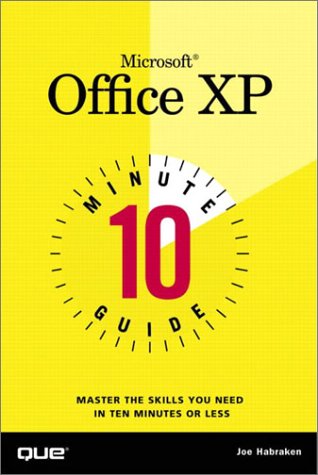

Most ebook files are in PDF format, so you can easily read them using various software such as Foxit Reader or directly on the Google Chrome browser.
Some ebook files are released by publishers in other formats such as .awz, .mobi, .epub, .fb2, etc. You may need to install specific software to read these formats on mobile/PC, such as Calibre.
Please read the tutorial at this link. https://ebooknice.com/page/post?id=faq
We offer FREE conversion to the popular formats you request; however, this may take some time. Therefore, right after payment, please email us, and we will try to provide the service as quickly as possible.
For some exceptional file formats or broken links (if any), please refrain from opening any disputes. Instead, email us first, and we will try to assist within a maximum of 6 hours.
EbookNice Team

Status:
Available0.0
0 reviews
ISBN 10: 0789726602
ISBN 13: 9780789726605
Author: Joe Habraken
Because most people don't have the luxury of sitting down uninterrupted for hours at a time to learn Office XP, this 10-Minute Guide focuses on the most often used features, covering them in lessons designed to take 10 minutes or less to complete. In addition, this guide teaches the user how to use Visio without relying on technical jargon, by providing straightforward, easy-to-follow explanations and lists of numbered steps that tell the user which keys to press and which options to select.
Chapter 1: What's New in Office XP
Introducing Microsoft Office XP
Introducing Voice Dictation and Voice Commands
Smart Tags Provide Quick Options
Introducing the Office Task Panes
Using Document Recovery
Understanding Product Activation
Chapter 2: Using Common Office Features
Starting Office Applications
Using the Menu System
Using Shortcut Menus
Working with Toolbars
Understanding Dialog Boxes
Understanding the Task Pane
Setting Application Options
Chapter 3: Getting Help in Microsoft Office
Help: What's Available?
Using the Ask a Question Box
Using the Office Assistant
Using the Help Window
Getting Help with Screen Elements
Chapter 4: Creating Mail
Understanding Microsoft Outlook
Composing a Message
Formatting Text
Selecting the E-mail Message Format
Add a Signature
Sending Mail
Chapter 5: Working with Received Mail
Reading Mail
Saving an Attachment
Answering Mail
Printing Mail
Deleting Mail
Forwarding Mail
Creating Folders
Chapter 6: Creating a Contacts List
Creating a New Contact
Viewing the Contacts List
Communicating with a Contact
Viewing a Map of a Contact's Address
Chapter 7: Using the Calendar
Navigating the Calendar
Creating an Appointment
Scheduling a Recurring Appointment
Planning Events
Chapter 8: Working with Word Documents
Starting a New Document
Entering Text
Using Document Templates
Using Word Wizards
Saving a Document
Closing a Document
Opening a Document
Chapter 9: Editing Documents
Adding or Replacing Text and Moving in the Document
Selecting Text
Deleting, Copying, and Moving Text
Copying and Moving Text Between Documents
Chapter 10: Changing How Text Looks
Understanding Fonts
Changing Font Attributes
Working in the Font Dialog Box
Aligning Text
Aligning Text with Click and Type
Chapter 11: Working with Styles
Understanding Styles
Creating Text Styles
Creating Paragraph Styles
Editing Styles
Using the Style Organizer
Chapter 12: Entering Data into an Excel Worksheet
Understanding Excel Data Types
Entering Text
Entering Numbers
Entering Dates and Times
Copying (Filling) the Same Data to Other Cells
Entering a Series of Numbers, Dates, and Other Data
Taking Advantage of AutoComplete
Chapter 13: Performing Simple Calculations in Excel
Understanding Excel Formulas
Order of Operations
Entering Formulas
Using the Status Bar AutoCalculate Feature
Editing Formulas
Chapter 14: Performing Calculations with Functions
What Are Functions?
Using the Insert Function Feature
Chapter 15: Creating Charts
Understanding Charting Terminology
Working with Different Chart Types
Creating and Saving a Chart
Moving and Resizing a Chart
Printing a Chart
Chapter 16: Creating a New Database
Choosing How to Create Your Database
Selecting a Database File Type
Creating a Blank Database
Closing a Database
Creating a Database from a Template
Opening a Database
Chapter 17: Creating an Access Table
Tables Are Essential
Working with the Table Wizard
Creating Tables Without the Wizard
Creating a Table in Table Design View
Setting the Primary Key
Understanding Data Types and Formats
Chapter 18: Creating a Simple Access Form
Creating Forms
Creating a Form with AutoForm
Creating a Form with the Form Wizard
Entering Data into a Form
Chapter 19: Creating a Simple Query
Understanding Queries
Using Other Query Wizards
Understanding Access Query Types
Chapter 20: Creating a New PowerPoint Presentation
Getting the Most Out of PowerPoint 2002
Three Choices for Starting a New Presentation
Saving a Presentation
Closing a Presentation
Opening a Presentation
Chapter 21: Completing Your PowerPoint Presentation
Inserting a New Slide
Deleting Slides
Viewing an Onscreen Slide Show
Setting Slide Animation Schemes
Setting Up a Self-Running Show
Chapter 22: Creating a FrontPage Web Site
Using the Web Site Wizards
Creating a New Web
Understanding the Web Views
Chapter 23: Working with Web Pages and Themes
Creating a New Web Page
Inserting a New Page into the Web
Deleting a Page from the Web
Importing Files from Other Applications
Using the FrontPage Themes
Chapter 24: Completing and Publishing Your Web Site
Using Tasks to Complete a Web
Inserting Pictures
Inserting Clip Art
Publishing Your Web
microsoft office tips and tricks 2021
10-minute office workout
microsoft office guide book
a guide to microsoft office 2010
a guide to microsoft office 2013
Tags: Joe Habraken, 10 Minute Guide, Microsoft Office